Blog
What can you plant in spring?
Spring: the time of year when we all breathe a sigh of relief and finally start soaking up some much-needed Vitamin D. It’s a time for new beginnings and renewal — and your garden is no exception to the rule!
March, April, May, and early June offer the perfect time to plant a huge variety of vegetables, herbs, flowers, and fruits — each with different harvest periods, so you can enjoy the fruits of your labour throughout the year.
So, let’s take a look at some of the best things to plant in spring, including some easy wins and trickier options for more seasoned gardeners. We’ll also dive into some of the plants most adored by wildlife so you can ensure your garden is filled with bees, butterflies, and birds alike.
Flowers to plant in Spring
Dahlias
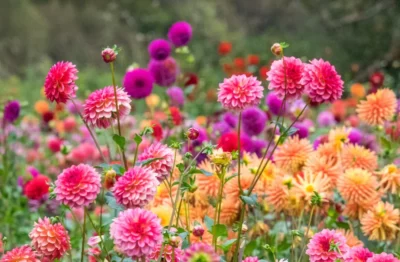
Difficulty level: easy.
Sow: between February and April.
Flower: between midsummer and autumn.
Care: with rich, well draining soil in a sunny spot.
With their impressive pom-pom-like blooms, it’s no surprise that dahlias are a much-loved flower in the UK. They’re easy to grow, too, and you can start from either seeds or tubers. For longer and better flowering in the first year, try growing from tubers.
Gladioli
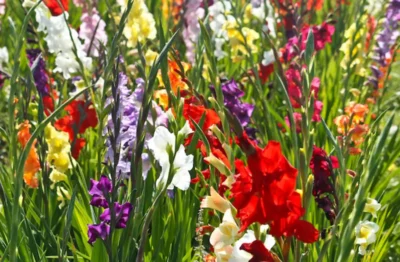
Difficulty level: medium.
Sow: between late-March and mid-April.
Flower: between late June and early July.
Care: with rich, well draining soil in a sunny spot.
Gladioli flower beautifully, with multiple heads to a stem. Their funnel-shaped flowers scoop off of the lusciously-green fronds and cluster like foxgloves — with their trumpets upwards rather than downwards. They come in all kinds of varieties, so you can choose to mix colours or stick with a single colour scheme.
Lilies
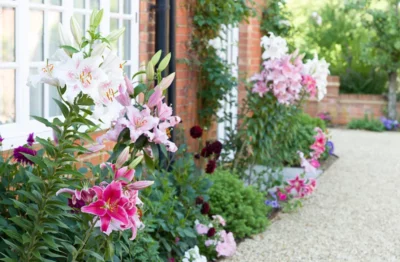
Difficulty level: easy.
Sow: ideally in early autumn, but can be planted in spring.
Flower: between late June and early July.
Care: with fairly moist but well draining soil, in a sunny or dappled spot.
These hardy plants are nowhere near as fussy as they look. Prized for their scent and magnificent blooms, Oriental lilies can be grown in acidic soil or ericaceous compost. Asiatic lilies prefer neutral/alkaline soil or multi-purpose compost.
Taller varieties may need protection with some support to prevent breakages in wind. Just watch out for your pets — lilies can be toxic to both dogs and cats.
Peonies
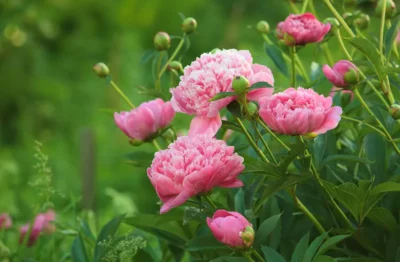
Difficulty level: easy.
Sow: between October and March, but potted plants can be planted into spring.
Flower: despite misconceptions, if you care for them correctly you may see them flower in the first year. They flower between late April and early June.
Care: with fertile soil (moist but well-drained) and full sun. Larger varieties may require stem support.
With their showy blooms, peonies are another British favourite for planting in spring. Their soft petals cluster on top of each other to form a bowl-like shape around their yellow stamen.
You’ll usually find them in shades of pink, but you can get your hands on some white varieties too. When young, they’ll be rather low-lying, but with time they can grow taller than 3 feet.
Agapanthus
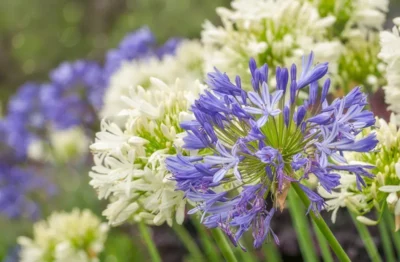
Difficulty level: easy to medium.
Sow: in spring, ideally March or April.
Flower: June, July, August.
Care: with well-watered, well-draining soil in full or partial sun.
Agapanthus’ purple-flowering heads and tall stems give them a striking appearance akin to the round blooms of garlic. While they can be planted in the ground and happily flower there, they generally tend to do best in terracotta pots that keep the roots warm and restrict their roots.
Prune dead flower heads and leaves and water regularly to maintain their fresh appearance throughout the summer. Once established, they’ll need much less water to thrive.
Begonias
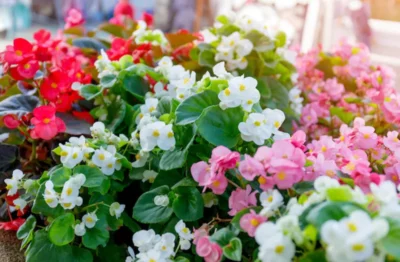
Difficulty level: easy to medium.
Sow: plant tubers in spring.
Flower: in summer until autumn/winter frosts.
Care: with light, fertile, well-drained soil and bright or dappled light.
These popular flowers are available in a huge variety of colours and shapes. With begonias, their beauty lies in their leaves – which are often spectacular – as well as their flowers.
You can encourage blooming with regular pruning to make the plant bushier. Keep in mind that they can be susceptible to root rot, which is why proper drainage is so important.
Fruits & vegetables to plant in spring
Tomatoes
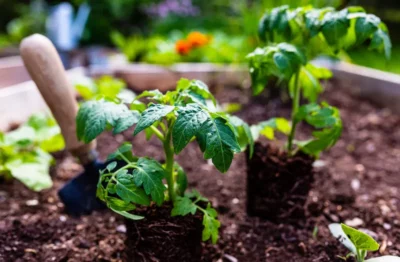
Difficulty level: tricky — especially when young. Try buying starters!
Sow: late March to early April.
Harvest: mid-summer onwards.
Care: use organic seaweed extract as a natural fertiliser, water regularly, and prune so growth is focused on fruiting rather than leaves.
Everybody loves tomatoes – and, ensuring you buy indeterminate varieties, you’ll be able to keep picking them again and again. These tomato plants are the gift that keeps on giving.
Determinate varieties, on the other hand, grow to a fixed size, fruit once, and then diminish. Some delicious indeterminate varieties to try your hand at include:
- Beefsteak
- Sweet Million
- Sungold
- Green Zebra
It’s also recommended to plant tomatoes alongside French marigolds, which help protect the tomatoes from some common pests.
Cut-and-come-again Lettuce
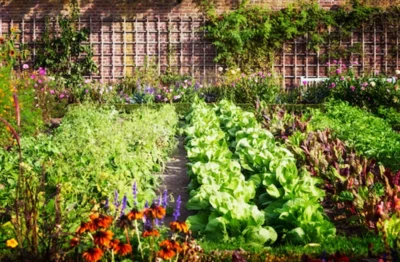
Difficulty level: easy to medium.
Sow: in spring and then every two weeks throughout the summer for a continuous supply.
Harvest: regularly throughout the summer if using loose-leafed varieties.
Care: by planting in a sunny spot and keeping soil moist.
Lettuce is a garden favourite. Unfortunately, it’s not just us humans that like to eat it! Slugs, snails, aphids, and even birds are particular fans of these leafy greens.
Protect them by covering them with a lightweight fabric and dispersing eggshells and seaweed extract around the rows. You can also grow lettuce in containers indoors if you find that you just can’t keep the pests away!
Carrots
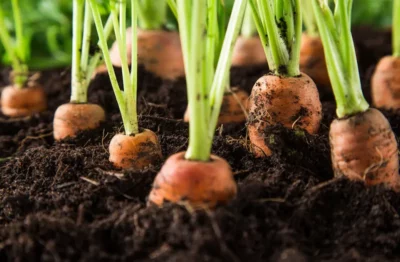
Difficulty level: easy.
Sow: in spring.
Harvest: three to four months after sowing.
Care: by planting in a sunny spot in well-draining soil.
If you’re new to planting root vegetables, carrots are a fairly easy one to grow. They’re generally quite drought-resistant, so will tolerate less water and are also fairly happy in containers if you don’t have much space.
Broad beans
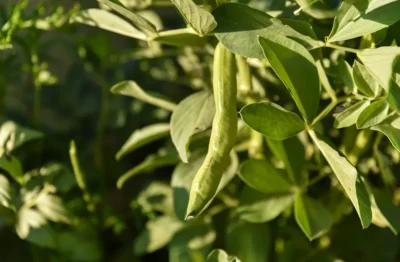
Difficulty level: easy.
Sow: if growing from seeds, plant them in February. Or, buy established plants to plant in spring.
Harvest: May through to September, peaking around July.
Care: with fertile, well-draining soil in a sunny spot and stakes/trellises for them to climb.
A rewarding crop for home gardeners, broad bean plants can produce ample crops and will keep producing if you pick them regularly (2 or 3 times a week).
When small, the whole pod can be cooked and eaten — they’ll still be soft. If the outside has gotten a little tough, though, just enjoy the beans!
Strawberries
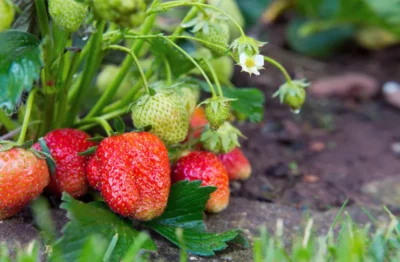
Difficulty level: easy.
Sow: mid-spring to early summer.
Harvest: from summer through to autumn.
Care: with well-draining soil and full sun.
You’ll be amazed how different strawberries taste when home-grown compared to those you’ll find in a supermarket. Fortunately, they’re adaptable and grow well in the ground, containers, and even hanging baskets.
Just ensure you space out plants to avoid overcrowding and remove weeds that might spread fungus. Prune off any runners and keep an eye out for Fusarium wilt, a fungal disease characterised by slow growth and discolouration.
What to plant for wildlife this Spring
More and more people are keen to make sure that their gardens are fit for wildlife. In a world where there are increasingly fewer places for creatures & critters to roam free, it’s crucial that we all do our part to create safe havens for them.
With that in mind, there are a few plants to try and get into your gardens this spring:
- Buddleia: this purple-blossomed shrub is adored by butterflies and can be planted in spring, though you will need to purchase an established one if you want to reap the benefits this year!
- Foxgloves: these tall plants with tubular flowers attract pollinators like bees, vital for your garden’s growth.
- Lavender: a gorgeous-smelling plant, lavender can be planted up until the end of May and will attract pollinators. It can also repel aphids and slugs.
- Chives, thyme, sage, and other herbs: perfect for spring planting, many herbs attract pollinators to your garden – and add interest to any dish!
- Honeysuckle: these climbing plants grow incredibly well and are enjoyed by all kinds of creatures — from bats and birds to insects.
- Sunflowers: bees, butterflies, and birds cherish these majestic, vibrant flowers, which can be sown until the end of May.
- Wild Cherry & Crab Apple trees: of course, you will need to buy these as mature trees if you’d like to see the wildlife enjoying them this year. These are much-loved by bees, insects, caterpillar moths, and birds!
Happy planting!
There you have it – a list of some of our favourite flowers, fruits, and vegetables to plant in spring. Of course, there are many more things you can sow throughout the season, like potatoes, onions, and radishes.
One of the best ways to start gardening is to simply start. We know that sounds easier said than done, but sometimes it can be as simple as taking a trip to the garden centre and seeing what takes your fancy. Head to the growing section and pick out any already-established plants — after all, whatever they have growing outdoors there will be ready for your garden too! If you’re unsure, ask one of the horticulture experts there for growing advice.
Knowing what compost and feed to use can feel like a minefield, but keep in mind that it’s often more simple than it first seems. For the most part, multi-purpose compost is going to be your best bet!
Spring is the perfect time to get your hands dirty and plant a beautiful garden full of colourful flowers, tasty fruits, and fresh vegetables. Whether you’re an experienced gardener or a beginner with a green thumb, there are plenty of options to choose from. So why not take advantage of the season and start planting today?
Learn more about who we are HERE
and if you’d like to find out more, do GET IN TOUCH
